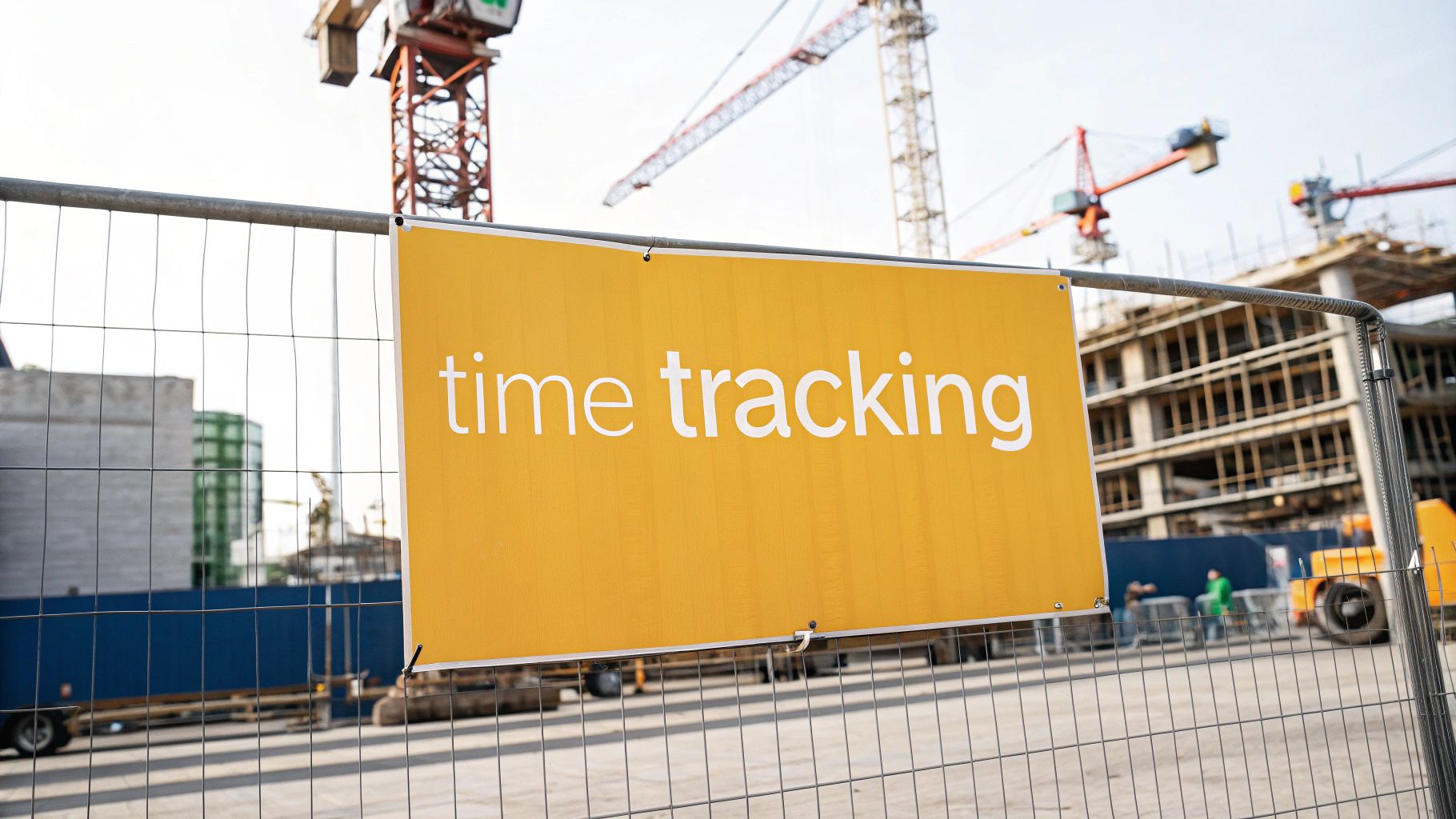From our resource library for organizational scheduling and management.
Time Tracking Software for Construction: Complete Guide to Maximizing Job Site Efficiency

Understanding Modern Construction Time Tracking Solutions

Construction projects involve multiple moving parts - workers, equipment, materials, and deadlines. Keeping track of all these elements accurately is crucial for project success and profitability. For years, construction companies relied on paper timesheets, which created endless headaches with errors and admin work. Now, digital solutions are changing how construction teams track time and manage projects.
Why Traditional Time Tracking Methods Fall Short
Paper timesheets come with major drawbacks. They're prone to mistakes from messy handwriting and manual data entry. Processing these sheets eats up valuable admin time that could be better spent on actual project needs. Without real-time data, managers can't make quick decisions, often leading to costly delays and budget issues.
The Rise of Time Tracking Software for Construction
New digital time tracking tools solve these common problems. They automatically collect data, removing human error from the equation. Features like GPS tracking and geofencing make it easy to verify worker hours and locations accurately. According to recent data, 68% of construction firms now use software to manage project finances, showing a clear move toward better cost tracking. Learn more about construction software adoption here: Construction Software Statistics
Key Benefits of Modern Solutions
Digital time tracking delivers several practical advantages:
- Real-time updates: Project managers can spot issues immediately and adjust plans before small problems become big ones
- Better teamwork: Field crews and office staff can share information instantly, reducing mix-ups
- Faster payroll: Time data flows directly into payroll systems, making payday smooth and accurate
- Smart scheduling: Managers can see exactly where workers and equipment are needed, improving job site efficiency
These improvements lead to smoother projects, better profits, and happier teams. The next section will look at specific features to consider when choosing time tracking software for construction work.
Essential Features That Drive Construction Efficiency
Modern time tracking software for construction goes far beyond basic clock-in and clock-out functions. These tools give construction managers clear insights into their projects, help them make smart decisions about resources, and keep work moving smoothly.
GPS Tracking and Geofencing
GPS tracking shows managers exactly where their workers are at any given time. This makes it simple to confirm that people are where they should be and provides clear proof of hours worked. When combined with geofencing, which sets up virtual boundaries around work sites, the system automatically records when workers enter and leave. This cuts down on time theft and makes payroll much more accurate.
Automated Timesheets and Payroll Integration
Paper timesheets are becoming a thing of the past. Automated systems remove the need for manual data entry and significantly reduce mistakes. The software connects directly with common accounting programs like QuickBooks, making it easy to process payroll and manage finances. This means less time spent on paperwork and more time focused on getting work done.
Real-Time Project Monitoring and Reporting
Project managers can now see exactly what's happening on their sites as it happens. They can quickly spot if labor costs are going over budget or if projects are falling behind schedule. The reporting tools turn all this information into clear insights that help managers plan better and use their resources more effectively. Learn more about crew scheduling in our guide: The Ultimate Guide to Construction Crew Scheduling Software
Equipment Tracking and Utilization
Many tracking systems now include features to monitor equipment use. This helps managers:
- Make sure expensive machines aren't sitting idle
- Schedule maintenance at the right times
- Get equipment to job sites when it's needed
- Reduce unnecessary rental costs
Construction companies can work more efficiently by using these features together. Having accurate, up-to-date information helps them make better decisions, reduce mistakes, and increase profits. For more details on timesheet solutions, visit: Construction Timesheet Software Solutions
Implementing Time Tracking Software Successfully

Making the switch to new time tracking software takes careful planning. While change can be challenging, having the right approach helps construction companies make a smooth transition. Here's how to get the most from your new system from day one.
Securing Buy-In and Managing Change
Getting everyone on board is essential when introducing new technology. This means including field workers, office staff, and managers in the process early on. Be upfront about why you're making the change - explain how automated timesheets will save foremen hours of paperwork and help workers get paid faster and more accurately. Listen to concerns, answer questions honestly, and give people time to adjust.
Developing Effective Training Programs
Keep training practical and focused on the features people will use every day. Mix up the learning formats - some people learn best through hands-on practice, while others prefer written guides or video tutorials. Consider offering:
- In-person workshops with real examples
- Short video tutorials for common tasks
- Written quick-start guides and FAQs
- One-on-one coaching for key team members
Good training builds confidence and leads to better adoption across the company.
Addressing Resistance and Maintaining Productivity
Some pushback is normal when rolling out new software. Create open channels for feedback and show how the system fixes current problems. To minimize disruption, consider running old and new systems in parallel for a short time. This gives teams breathing room to learn while keeping work moving forward. You might be interested in: Essential Apps for Construction Company Success
Measuring Implementation Success
Track clear metrics to gauge how well the rollout is going:
- Error rates: Compare timesheet accuracy before and after
- Processing time: Measure if payroll runs faster now
- Data quality: Check if managers can make better decisions
- Employee feedback: Survey teams about ease of use
Review these numbers regularly to spot issues early. Use the insights to fine-tune your processes and get more value from your investment. With good planning and follow-through, your new time tracking system can deliver real benefits while keeping disruption low.
Maximizing ROI Through Data-Driven Insights

Construction time tracking software goes beyond basic hour logging. It generates valuable data that smart project managers can analyze to boost their bottom line. By understanding what the numbers really mean, you can make better decisions that lead to more successful projects.
Identifying Meaningful Patterns and Benchmarks
Your time tracking data shows real patterns in how work gets done. You might spot that certain teams finish tasks quicker than others, or notice specific project phases that regularly go over budget. This helps you set clear performance standards and figure out what needs improvement. When you know what "good" looks like, you can measure progress more accurately and set achievable goals for your next projects.
Creating Actionable Reports
Raw numbers don't help unless you can understand them easily. Good construction time tracking tools let you create visual reports showing key information like labor costs, project status, and equipment use. Make these reports work for you by focusing on what matters most to your business. For example, if you see high overtime costs with one crew month after month, that's a clear sign you need to look at training or planning improvements.
Using Historical Data for Future Planning
Past project data is pure gold for planning ahead. By looking back at completed work, you get a clear picture of how long things really take, what resources you need, and where problems tend to pop up. This knowledge helps you write more accurate bids and place your crews where they'll work best. You can spot potential issues before they cost you money and build better project schedules based on real experience. Each completed project teaches lessons that make the next one run smoother.
Integration Capabilities and Ecosystem Benefits
A well-planned construction technology ecosystem helps teams work more efficiently by connecting key tools and data. Many leading construction companies are seeing major productivity gains by thoughtfully integrating their essential software systems.
Connecting Time Tracking With Other Essential Tools
When you connect your time tracking software to other key systems, you unlock valuable efficiencies. For example, linking with QuickBooks removes manual data entry for payroll, reducing errors and saving hours of work. Project management integration gives managers instant visibility into labor costs versus budgets, helping catch issues early. Equipment tracking connections provide clear insights into resource usage and availability.
Strategies for Successful Integration
To get the most from your integrated systems, follow these key practices:
- Review compatibility first: Make sure your time tracking software works smoothly with your current accounting, project management and equipment systems
- Focus on core needs: Begin with the most important connections like payroll and project tracking to see quick wins
- Test thoroughly: Run comprehensive tests in a controlled environment before full rollout
- Support your team: Provide clear training on the integrated tools to help everyone use them effectively
Evaluating Integration Options and Avoiding Challenges
When choosing integration options, look closely at ease of use, data security, and vendor support quality. Research customer reviews and implementation track records to avoid common problems. Check out our guide on staff roster programs for more workforce management insights. Taking time to evaluate options carefully helps ensure your system runs smoothly.
Benefits of a Connected Ecosystem
Connecting your construction software systems delivers clear advantages:
- Simpler workflows: Automatic data sharing between systems reduces manual work
- Better accuracy: Fewer data entry points means fewer mistakes in your records
- Clearer insights: Get up-to-date views of project status and resource use to make better choices
- Higher profits: Smart resource planning and cost control improve your bottom line
By focusing on smart integration, construction teams can get more value from their time tracking software while building a more effective operation.
Future Trends and Technologies Reshaping Construction Management

The construction industry is going through major tech changes right now. Keeping up with these developments isn't just nice to have - it's essential for success. Let's look at the key technologies that are changing how construction teams track time and manage projects.
AI and Machine Learning in Practice
Artificial intelligence and machine learning are moving from theory to everyday tools on construction sites. These systems can process data from time tracking software to spot patterns and flag potential issues before they become problems. For instance, AI tools can look at past project data and current weather to warn about possible delays. This gives project managers the info they need to make smart decisions and keep work on schedule.
Connected Job Sites with IoT
Internet of Things (IoT) technology is bringing construction equipment and tools online in practical ways. From machinery sensors to smart safety gear, these connected devices send real-time updates about what's happening on site. You can track equipment usage, get maintenance alerts, and see exactly how resources are being used. This detailed view helps teams plan better and fix small issues before they cause big delays.
Getting Your Team Ready for Change
While these new tools offer clear benefits, success depends on proper preparation. Start by choosing time tracking software that works well with newer technologies as they emerge. Just as important is helping your team build confidence with these tools through proper training. When workers understand and feel comfortable with new tech, they're more likely to use it effectively.
Smart Steps to Stay Ahead
- Move key systems to the cloud: Cloud systems make it easier to add new features and adapt as needs change
- Take data protection seriously: Strong security for your time tracking and project data isn't optional anymore
- Keep learning: Make sure your team has time and resources to learn about new tools and methods that could help your projects
Construction companies that start using these technologies thoughtfully can work more efficiently, finish projects faster, and stay ahead of their competition.
Want to improve how you schedule workers and track time on your construction projects? Check out Acroroster to see how our solution can help.